Regulating the Electron Depletion Layer of Au/V2O5/Ag Thin Film Sensor for Breath Acetone as Potential Volatile Biomarker
Abstract
1. Introduction
2. Materials and Methods
2.1. Synthesis of Ag NPs/V2O5 Thin Film/Au NPs
2.1.1. Fabrication of Ag NPs Thin Films
2.1.2. Fabrication of V2O5 Thin Film-Coated Ag NPs
2.1.3. Fabrication of Ag NPs/V2O5 Thin Film/Au NPs
2.2. Characterization Techniques
2.3. Gas Sensing Measurements
3. Results and Discussion
3.1. Materials Characterization
3.2. Gas Sensing Properties
3.3. Sensing Mechanism
4. Conclusions
Author Contributions
Funding
Institutional Review Board Statement
Informed Consent Statement
Data Availability Statement
Acknowledgments
Conflicts of Interest
References
- Gouma, P.; Kalyanasundaram, K.; Yun, X.; Stanaćević, M.; Wang, L. Nanosensor and Breath Analyzer for Ammonia Detection in Exhaled Human Breath. IEEE Sens. J. 2010, 10, 49–53. [Google Scholar] [CrossRef]
- Pleil, J.D.; Lindstrom, A.B. Exhaled Human Breath Measurement Method for Assessing Exposure to Halogenated Volatile Organic Compounds. Clin. Chem. 1997, 43, 723–730. [Google Scholar] [CrossRef] [PubMed]
- Das, S.; Pal, M. Review—Non-Invasive Monitoring of Human Health by Exhaled Breath Analysis: A Comprehensive Review. J. Electrochem. Soc. 2020, 167, 037562. [Google Scholar] [CrossRef]
- Santhosh Kumar, R.; Govindan, K.; Ramakrishnan, S.; Kim, A.R.; Kim, J.S.; Yoo, D.J. Fe3O4 Nanorods Decorated on Polypyrrole/Reduced Graphene Oxide for Electrochemical Detection of Dopamine and Photocatalytic Degradation of Acetaminophen. Appl. Surf. Sci. 2021, 556, 149765. [Google Scholar] [CrossRef]
- Amala, G.; Saravanan, J.; Jin Yoo, D.; Kim, A.R.; Gnana Kumar, G. An Environmentally Benign One Pot Green Synthesis of Reduced Graphene Oxide Based Composites for the Enzyme Free Electrochemical Detection of Hydrogen Peroxide. New J. Chem. 2017, 41, 4022–4030. [Google Scholar] [CrossRef]
- Teranishi, R.; Mon, T.R.; Robinson, A.B.; Cary, P.; Pauling, L. Gas Chromatography of Volatiles from Breath and Urine. Anal. Chem. 1972, 44, 18–20. [Google Scholar] [CrossRef]
- Minh, T.D.C.; Blake, D.R.; Galassetti, P.R. The Clinical Potential of Exhaled Breath Analysis for Diabetes Mellitus. Diabetes Res. Clin. Pract. 2012, 97, 195–205. [Google Scholar] [CrossRef]
- Popov, T.A. Human Exhaled Breath Analysis. Ann. Allergy Asthma Immunol. 2011, 106, 451–456. [Google Scholar] [CrossRef]
- Mehaney, A.; Alrowaili, Z.A.; Elsayed, H.A.; Taha, T.A.; Ahmed, A.M. Theoretical Investigations of Tamm Plasmon Resonance for Monitoring of Isoprene Traces in the Exhaled Breath: Towards Chronic Liver Fibrosis Disease Biomarkers. Phys. Lett. A 2021, 413, 127610. [Google Scholar] [CrossRef]
- Jia, Z.; Patra, A.; Kutty, V.K.; Venkatesan, T. Critical Review of Volatile Organic Compound Analysis in Breath and In Vitro Cell Culture for Detection of Lung Cancer. Metabolites 2019, 9, 52. [Google Scholar] [CrossRef]
- Sun, Y.; Fan, X.; Zhao, J. Development of Colorectal Cancer Detection and Prediction Based on Gut Microbiome Big-Data. Med. Microecol. 2022, 12, 100053. [Google Scholar] [CrossRef]
- Mathew, T.L.; Pownraj, P.; Abdulla, S.; Pullithadathil, B. Technologies for Clinical Diagnosis Using Expired Human Breath Analysis. Diagnostics 2015, 5, 27–60. [Google Scholar] [CrossRef] [PubMed]
- Güntner, A.T.; Abegg, S.; Königstein, K.; Gerber, P.A.; Schmidt-Trucksäss, A.; Pratsinis, S.E. Breath Sensors for Health Monitoring. ACS Sens. 2019, 4, 268–280. [Google Scholar] [CrossRef] [PubMed]
- O’Hara, M.E.; Clutton-Brock, T.H.; Green, S.; Mayhew, C.A. Endogenous Volatile Organic Compounds in Breath and Blood of Healthy Volunteers: Examining Breath Analysis as a Surrogate for Blood Measurements. J. Breath Res. 2009, 3, 027005. [Google Scholar] [CrossRef]
- Buszewski, B.; Kesy, M.; Ligor, T.; Amann, A. Human Exhaled Air Analytics: Biomarkers of Diseases. Biomed. Chromatogr. 2007, 21, 553–566. [Google Scholar] [CrossRef]
- Fenske, J.D.; Paulson, S.E. Human Breath Emissions of VOCs. J. Air Waste Manag. Assoc. 2011, 49, 594–598. [Google Scholar] [CrossRef]
- Amiri, V.; Roshan, H.; Mirzaei, A.; Neri, G.; Ayesh, A.I. Nanostructured Metal Oxide-Based Acetone Gas Sensors: A Review. Sensors 2020, 20, 3096. [Google Scholar] [CrossRef]
- Rudnicka, J.; Walczak, M.; Kowalkowski, T.; Jezierski, T.; Buszewski, B. Determination of Volatile Organic Compounds as Potential Markers of Lung Cancer by Gas Chromatography–Mass Spectrometry versus Trained Dogs. Sens. Actuators B Chem. 2014, 202, 615–621. [Google Scholar] [CrossRef]
- Machado, R.F.; Laskowski, D.; Deffenderfer, O.; Burch, T.; Zheng, S.; Mazzone, P.J.; Mekhail, T.; Jennings, C.; Stoller, J.K.; Pyle, J.; et al. Detection of Lung Cancer by Sensor Array Analyses of Exhaled Breath. Am. J. Respir. Crit. Care Med. 2012, 171, 1286–1291. [Google Scholar] [CrossRef]
- Rudnicka, J.; Kowalkowski, T.; Buszewski, B. Searching for Selected VOCs in Human Breath Samples as Potential Markers of Lung Cancer. Lung Cancer 2019, 135, 123–129. [Google Scholar] [CrossRef]
- Vajhadin, F.; Mazloum-Ardakani, M.; Amini, A. Metal Oxide-Based Gas Sensors for the Detection of Exhaled Breath Markers. Med. Devices Sens. 2021, 4, e10161. [Google Scholar] [CrossRef] [PubMed]
- Righettoni, M.; Amann, A.; Pratsinis, S.E. Breath Analysis by Nanostructured Metal Oxides as Chemo-Resistive Gas Sensors. Mater. Today 2015, 18, 163–171. [Google Scholar] [CrossRef]
- Wang, Z.; Ali Haidry, A.; Xie, L.; Zavabeti, A.; Li, Z.; Yin, W.; Lontio Fomekong, R.; Saruhan, B. Acetone Sensing Applications of Ag Modified TiO2 Porous Nanoparticles Synthesized via Facile Hydrothermal Method. Appl. Surf. Sci. 2020, 533, 147383. [Google Scholar] [CrossRef]
- Yoo, R.; Park, Y.; Jung, H.; Rim, H.J.; Cho, S.; Lee, H.-S.; Lee, W. Acetone-Sensing Properties of Doped ZnO Nanoparticles for Breath-Analyzer Applications. J. Alloys Compd. 2019, 803, 135–144. [Google Scholar] [CrossRef]
- Jing, R.; Ibni Khursheed, A.; Song, J.; Sun, L.; Yu, Z.; Nie, Z.; Cao, E. A Comparative Study on the Acetone Sensing Properties of ZnO Disk Pairs, Flowers, and Walnuts Prepared by Hydrothermal Method. Appl. Surf. Sci. 2022, 591, 153218. [Google Scholar] [CrossRef]
- Jia, X.; Yu, S.; Cheng, C.; Yang, J.; Li, Y.; Wang, S.; Song, H. Ag Nanoparticles Modified Fe3O4/Reduced Graphene Oxide and Their Acetone Sensing Properties. Mater. Chem. Phys. 2022, 276, 125378. [Google Scholar] [CrossRef]
- Kim, H.; Cai, Z.; Chang, S.P.; Park, S. Improved Sub-Ppm Acetone Sensing Properties of SnO2 Nanowire-Based Sensor by Attachment of Co3O4 Nanoparticles. J. Mater. Res. Technol. 2020, 9, 1129–1136. [Google Scholar] [CrossRef]
- Shameli, K.; Ahmad, M.B.; Jazayeri, S.D.; Sedaghat, S.; Shabanzadeh, P.; Jahangirian, H.; Mahdavi, M.; Abdollahi, Y. Synthesis and Characterization of Polyethylene Glycol Mediated Silver Nanoparticles by the Green Method. Int. J. Mol. Sci. 2012, 13, 6639–6650. [Google Scholar] [CrossRef]
- Graupner, R. Raman Spectroscopy of Covalently Functionalized Single-Wall Carbon Nanotubes. J. Raman Spectrosc. 2007, 38, 673–683. [Google Scholar] [CrossRef]
- Boolchand, P.; Jin, M.; Novita, D.I.; Chakravarty, S. Raman Scattering as a Probe of Intermediate Phases in Glassy Networks. J. Raman Spectrosc. 2007, 38, 660–672. [Google Scholar] [CrossRef]
- Gouadec, G.; Colomban, P. Raman Spectroscopy of Nanomaterials: How Spectra Relate to Disorder, Particle Size and Mechanical Properties. Prog. Cryst. Growth Charact. Mater. 2007, 53, 1–56. [Google Scholar] [CrossRef]
- Stamplecoskie, K.G.; Scaiano, J.C.; Tiwari, V.S.; Anis, H. Optimal Size of Silver Nanoparticles for Surface-Enhanced Raman Spectroscopy. J. Phys. Chem. C 2011, 115, 1403–1409. [Google Scholar] [CrossRef]
- Gouadec, G.; Colomban, P. Raman Spectroscopy of Nanostructures and Nanosized Materials. J. Raman Spectrosc. 2007, 38, 598–603. [Google Scholar] [CrossRef]
- Irmer, G. Raman Scattering of Nanoporous Semiconductors. J. Raman Spectrosc. 2007, 38, 634–646. [Google Scholar] [CrossRef]
- Li, H.B.; Xiao, J.; Yang, G.W. Silver Nanoparticles Synthesized by Laser Ablation in Liquids and Application for Surface-Enhanced Raman Scattering. Physics, Chemistry and Applications of Nanostructures. In Proceedings of the International Conference Nanomeeting—2013, Minsk, Belarus, 28–31 May 2013; pp. 426–429. [Google Scholar] [CrossRef]
- Gotić, M.; Popović, S.; Ivanda, M.; Musić, S. Sol–Gel Synthesis and Characterization of V2O5 Powders. Mater. Lett. 2003, 57, 3186–3192. [Google Scholar] [CrossRef]
- Liu, Y.; Chen, Q.; Du, X.; Liu, X.; Li, P. Effects of Substrate on the Structure and Properties of V2O5 Thin Films Prepared by the Sol-Gel Method. AIP Adv. 2019, 9, 045028. [Google Scholar] [CrossRef]
- Grayli, S.V.; Leach, G.W.; Bahreyni, B. Sol-Gel Deposition and Characterization of Vanadium Pentoxide Thin Films with High TCR. Sens. Actuators A Phys. 2018, 279, 630–637. [Google Scholar] [CrossRef]
- Alsawafta, M.; Almoabadi, A.; Badilescu, S.; Truong, V.-V. Improved Electrochromic Properties of Vanadium Pentoxide Nanorods Prepared by Thermal Treatment of Sol-Gel Dip-Coated Thin Films. J. Electrochem. Soc. 2015, 162, H466–H472. [Google Scholar] [CrossRef]
- Liu, Y.; Du, X.; Liu, X. Effect of Annealing on The Properties of Vanadium Pentoxide Films Prepared by Sol–Gel Method. Surf. Rev. Lett. 2014, 21, 1450027. [Google Scholar] [CrossRef]
- Ureña-Begara, F.; Crunteanu, A.; Raskin, J.P. Raman and XPS Characterization of Vanadium Oxide Thin Films with Temperature. Appl. Surf. Sci. 2017, 403, 717–727. [Google Scholar] [CrossRef]
- Priya, B.; Jasrotia, P.; Sulania, I.; Kumar, R.; Pandey, R.K.; Kumar, T. Substrate-dependent fractal growth and wettability of N+ ion implanted V2O5 thin films. Appl. Surf. Sci 2023, 619, 156592. [Google Scholar] [CrossRef]
- Bosco, J.; Rayappan, B. Gas Sensing Mechanism of Metal Oxides: The Role of Ambient Atmosphere, Type of Semiconductor and Gases-A Review. Sci. Lett. J. 2015, 4, 126. [Google Scholar]
- Ji, H.; Zeng, W.; Li, Y. Gas Sensing Mechanisms of Metal Oxide Semiconductors: A Focus Review. Nanoscale 2019, 11, 22664–22684. [Google Scholar] [CrossRef] [PubMed]
- Staerz, A.; Weimar, U.; Barsan, N. Current State of Knowledge on the Metal Oxide Based Gas Sensing Mechanism. Sens. Actuators B Chem. 2022, 358, 131531. [Google Scholar] [CrossRef]
- B, S.; John, A.; Panda, P.K. A Review on Metal-Oxide Based p-n and n-n Heterostructured Nano-Materials for Gas Sensing Applications. Sens. Int. 2021, 2, 100085. [Google Scholar] [CrossRef]
- Paul, R.; Das, B.; Ghosh, R. Novel Approaches towards Design of Metal Oxide Based Hetero-Structures for Room Temperature Gas Sensor and Its Sensing Mechanism: A Recent Progress. J. Alloys Compd. 2023, 941, 168943. [Google Scholar] [CrossRef]
- Sun, Y.F.; Liu, S.B.; Meng, F.L.; Liu, J.Y.; Jin, Z.; Kong, L.T.; Liu, J.H. Metal Oxide Nanostructures and Their Gas Sensing Properties: A Review. Sensors 2012, 12, 2610–2631. [Google Scholar] [CrossRef]
- Meng, F.J.; Xin, R.F.; Li, S.X. Metal Oxide Heterostructures for Improving Gas Sensing Properties: A Review. Materials 2022, 16, 263. [Google Scholar] [CrossRef]
- Franco, M.A.; Conti, P.P.; Andre, R.S.; Correa, D.S. A Review on Chemiresistive ZnO Gas Sensors. Sens. Actuators Rep. 2022, 4, 100100. [Google Scholar] [CrossRef]
- Patil, S.A.; Jagdale, P.B.; Singh, A.; Singh, R.V.; Khan, Z.; Samal, A.K.; Saxena, M. 2D Zinc Oxide—Synthesis, Methodologies, Reaction Mechanism, and Applications. Small 2023, 19, 2206063. [Google Scholar] [CrossRef]
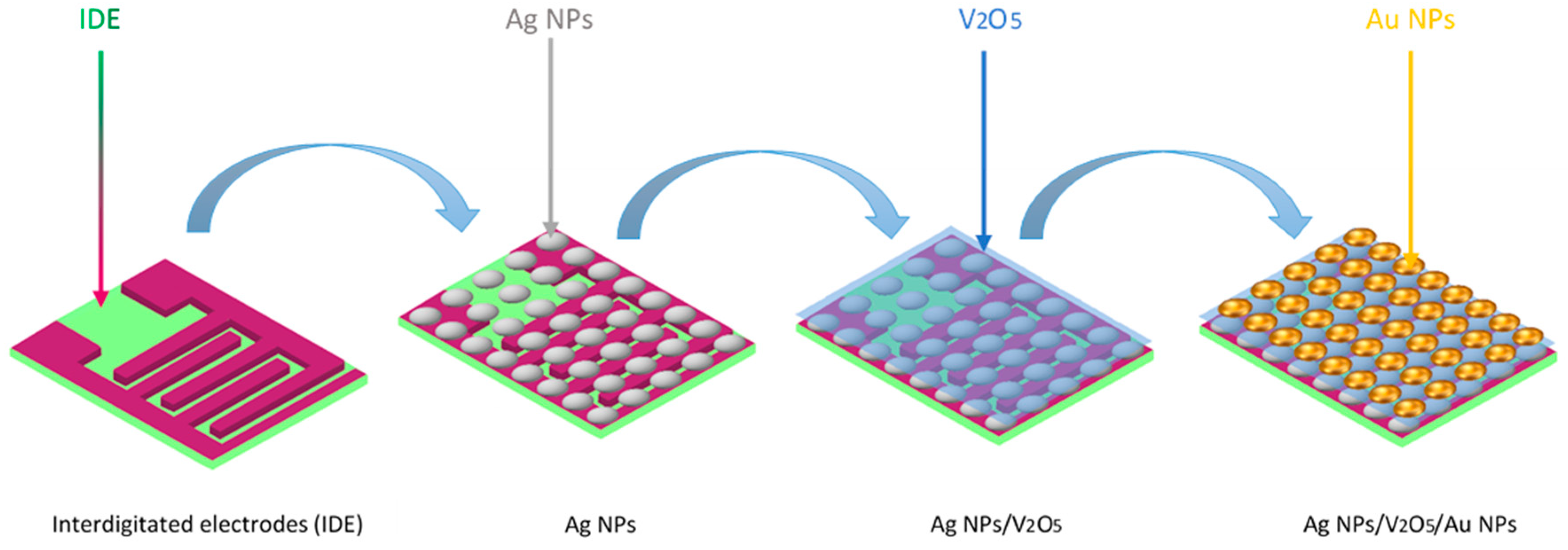
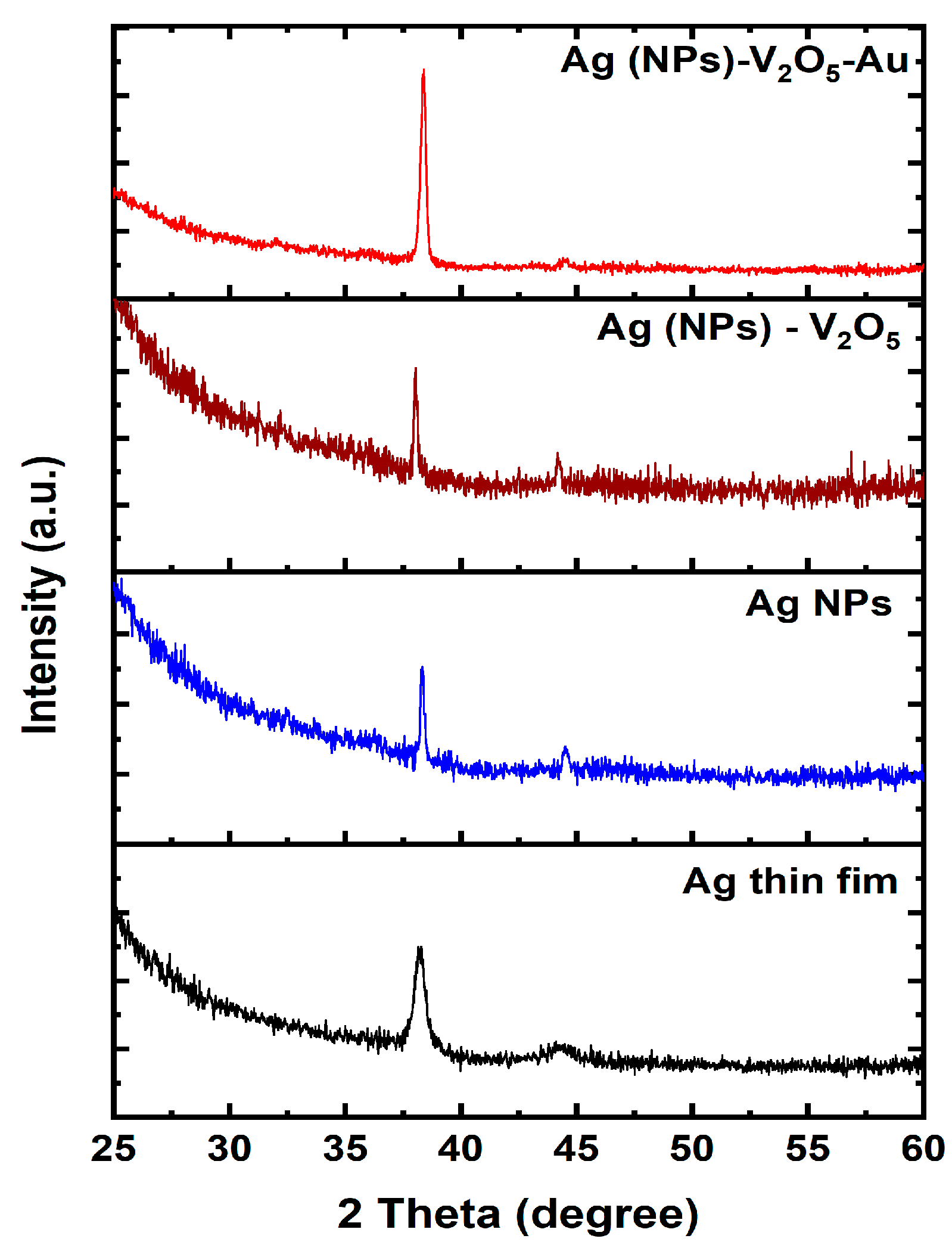
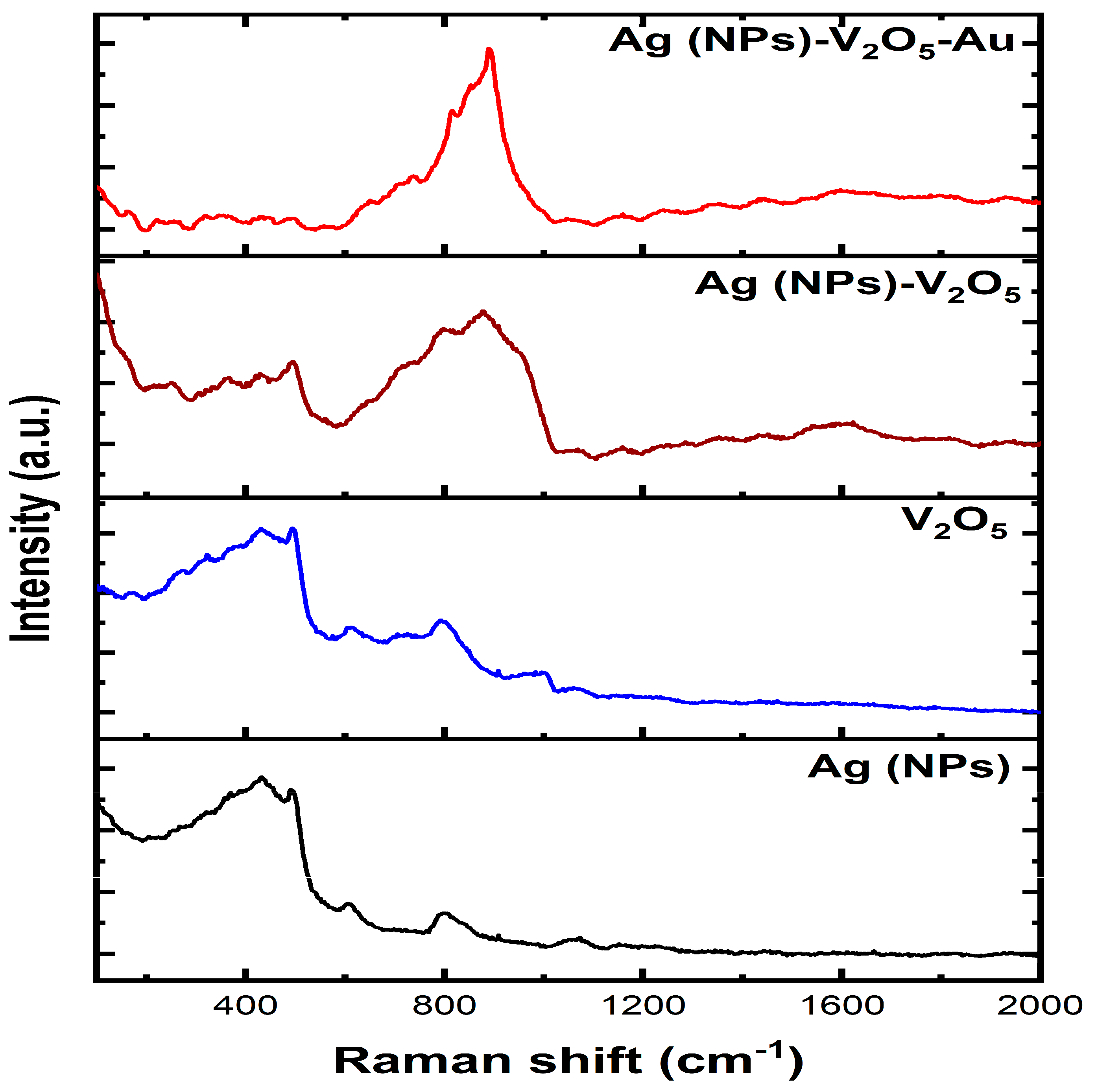
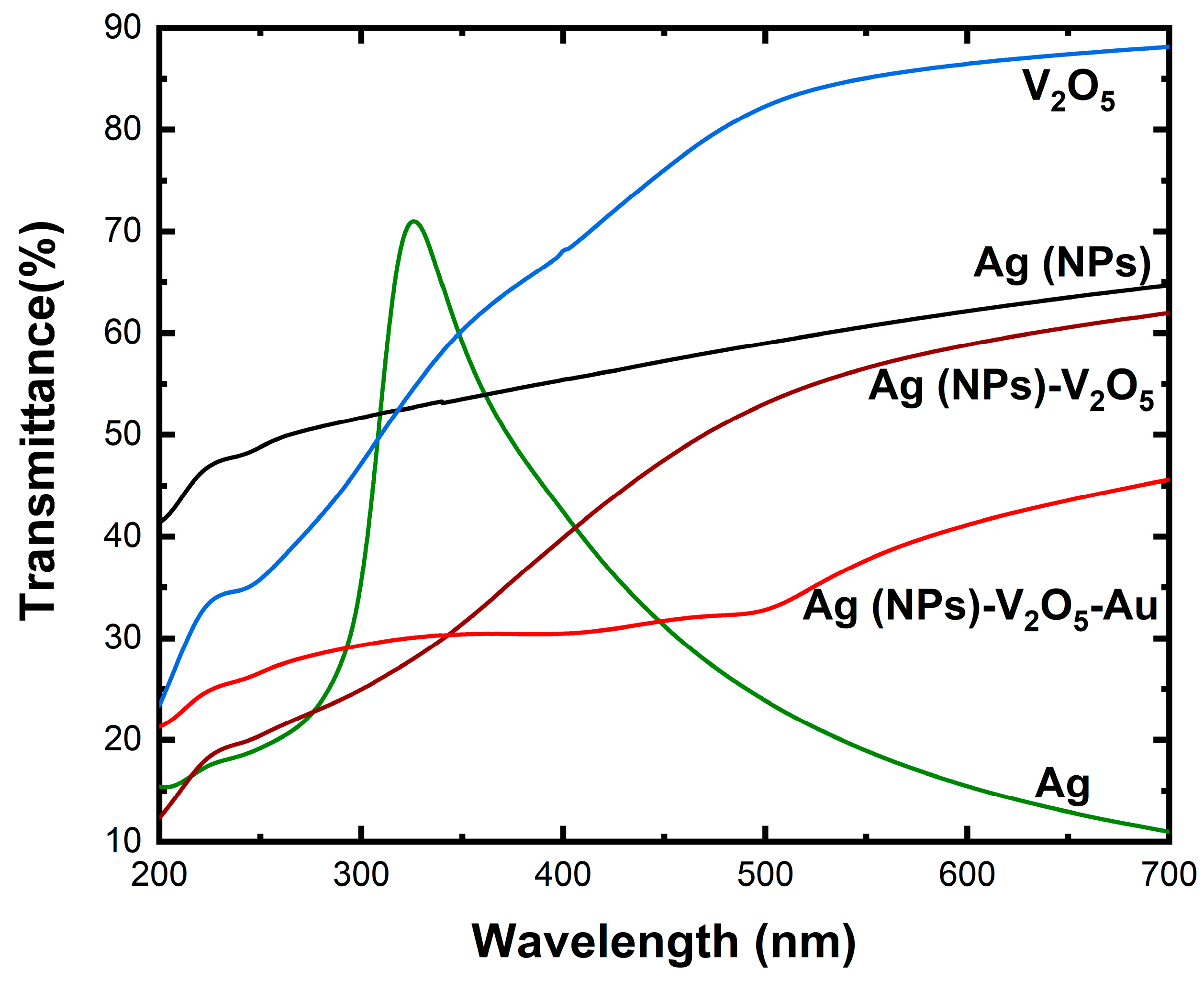
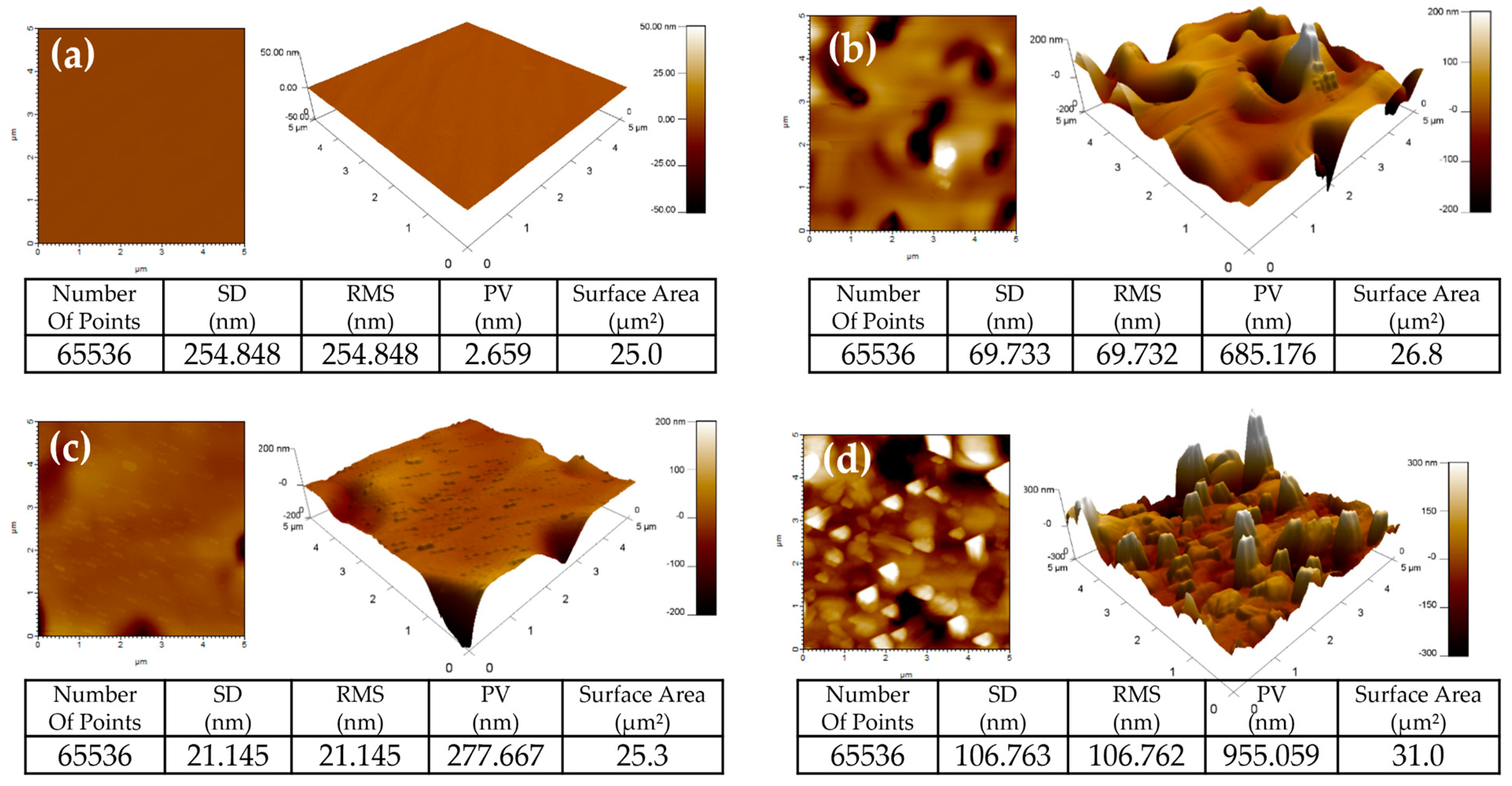
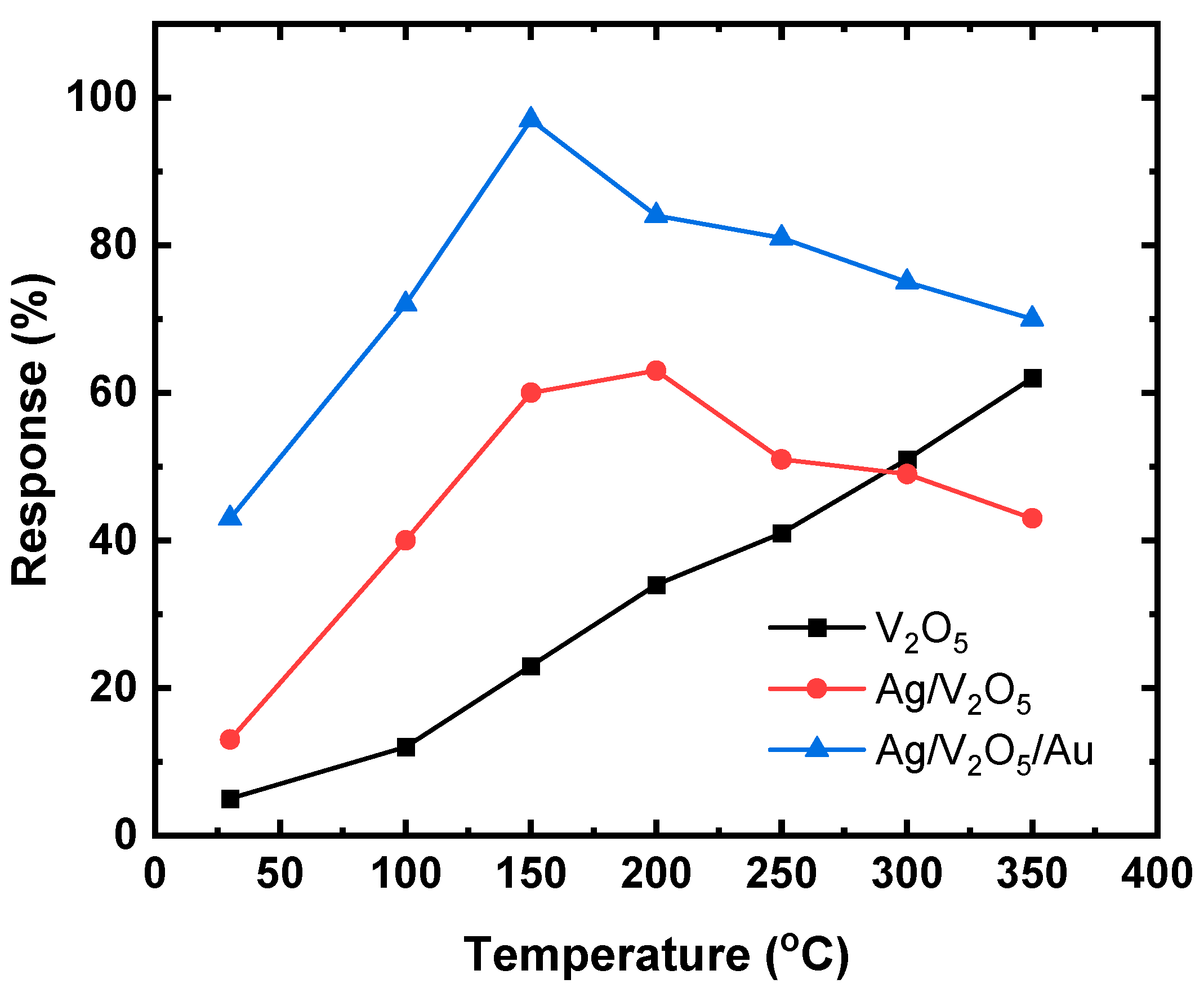
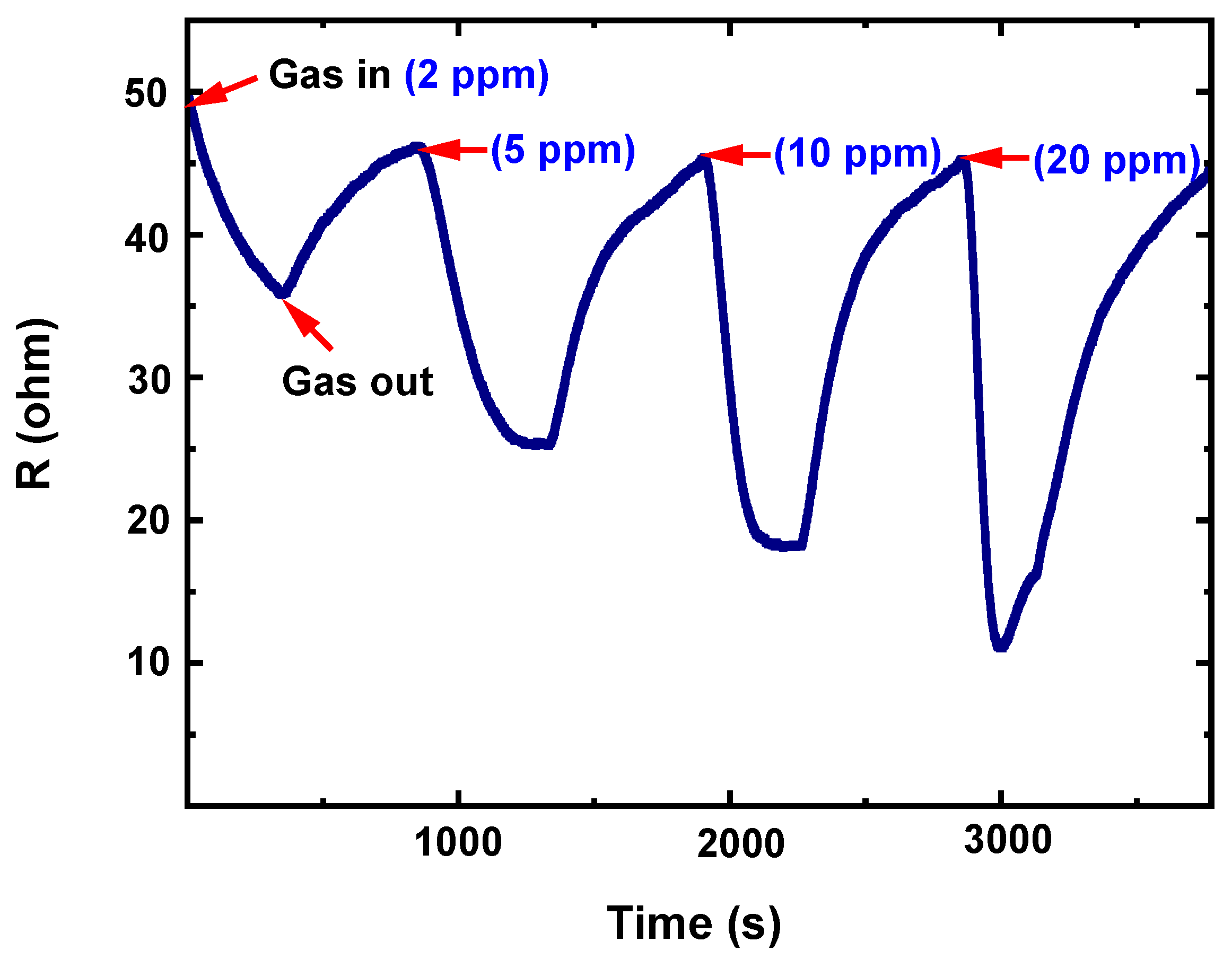
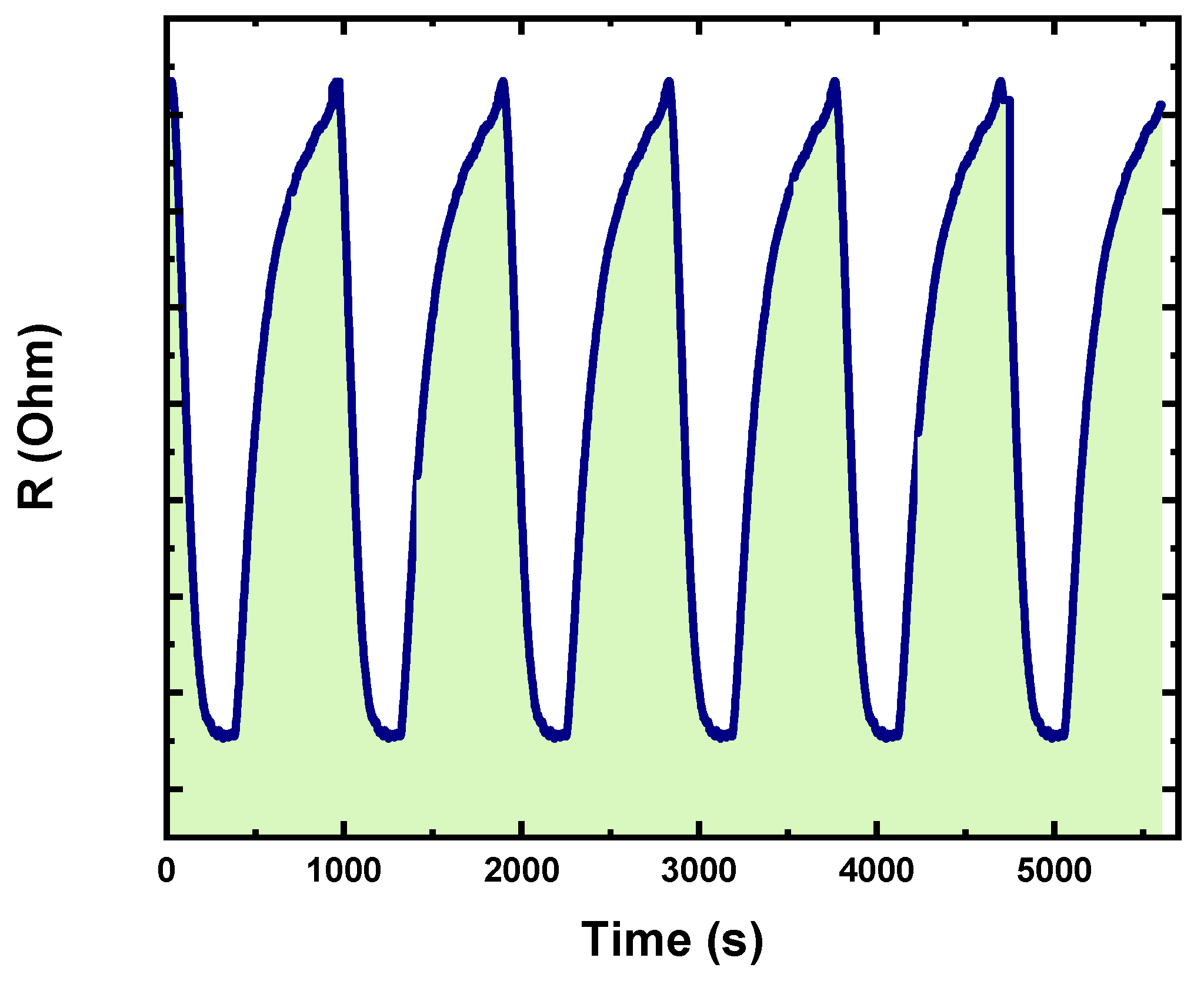
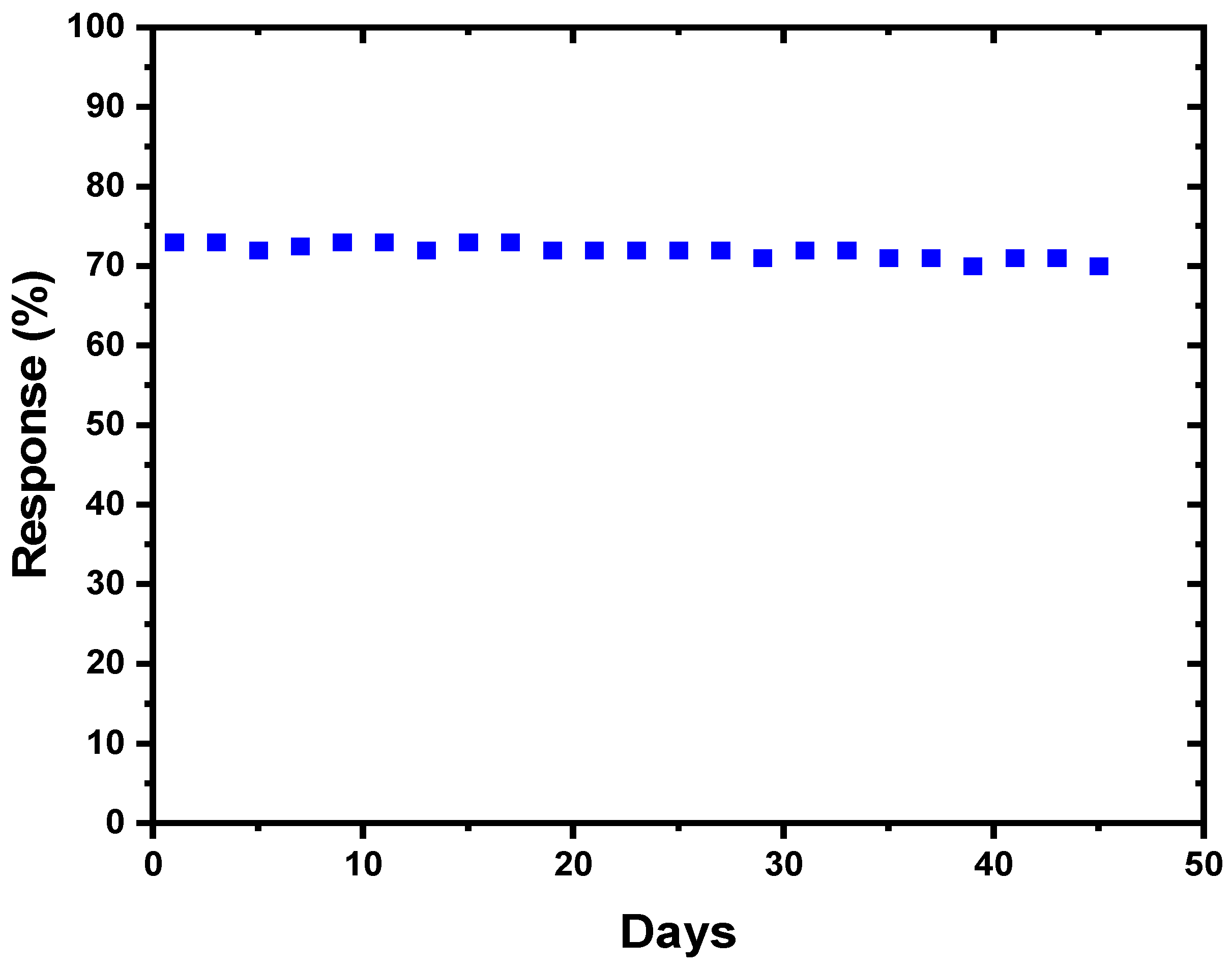
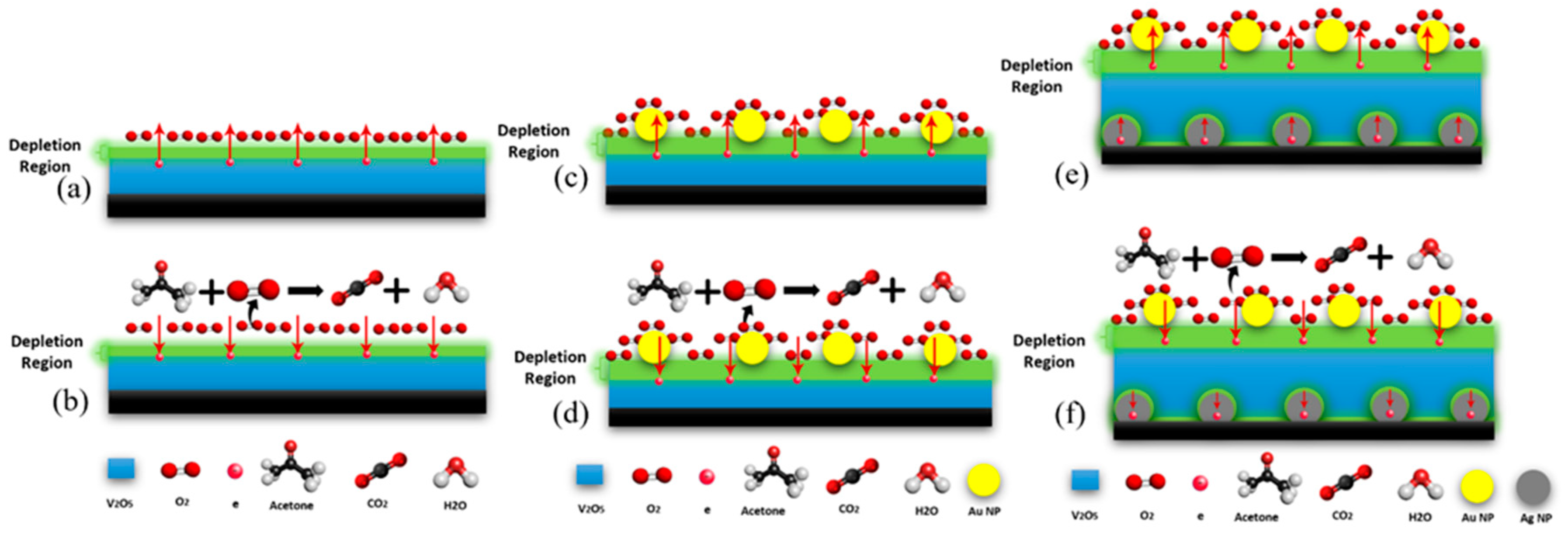
Disclaimer/Publisher’s Note: The statements, opinions and data contained in all publications are solely those of the individual author(s) and contributor(s) and not of MDPI and/or the editor(s). MDPI and/or the editor(s) disclaim responsibility for any injury to people or property resulting from any ideas, methods, instructions or products referred to in the content. |
© 2023 by the authors. Licensee MDPI, Basel, Switzerland. This article is an open access article distributed under the terms and conditions of the Creative Commons Attribution (CC BY) license (https://creativecommons.org/licenses/by/4.0/).
Share and Cite
Alghamdi, B.M.; Alharbi, N.M.; Alade, I.O.; Sultan, B.; Aburuzaizah, M.M.; Baroud, T.N.; Drmosh, Q.A. Regulating the Electron Depletion Layer of Au/V2O5/Ag Thin Film Sensor for Breath Acetone as Potential Volatile Biomarker. Nanomaterials 2023, 13, 1372. https://doi.org/10.3390/nano13081372
Alghamdi BM, Alharbi NM, Alade IO, Sultan B, Aburuzaizah MM, Baroud TN, Drmosh QA. Regulating the Electron Depletion Layer of Au/V2O5/Ag Thin Film Sensor for Breath Acetone as Potential Volatile Biomarker. Nanomaterials. 2023; 13(8):1372. https://doi.org/10.3390/nano13081372
Chicago/Turabian StyleAlghamdi, Bader Mohammed, Nawaf Mutab Alharbi, Ibrahim Olanrewaju Alade, Badriah Sultan, Mohammed Mansour Aburuzaizah, Turki N. Baroud, and Qasem A. Drmosh. 2023. "Regulating the Electron Depletion Layer of Au/V2O5/Ag Thin Film Sensor for Breath Acetone as Potential Volatile Biomarker" Nanomaterials 13, no. 8: 1372. https://doi.org/10.3390/nano13081372
APA StyleAlghamdi, B. M., Alharbi, N. M., Alade, I. O., Sultan, B., Aburuzaizah, M. M., Baroud, T. N., & Drmosh, Q. A. (2023). Regulating the Electron Depletion Layer of Au/V2O5/Ag Thin Film Sensor for Breath Acetone as Potential Volatile Biomarker. Nanomaterials, 13(8), 1372. https://doi.org/10.3390/nano13081372






